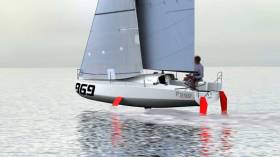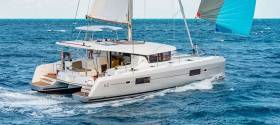Displaying items by tag: Dusseldorf Boat Show
Irish Sailors Share in Dusseldorf Boat Show’s Golden Jubilee
Unlike the pampered fresh-out of-the-box superyachts which have been brought up the Rhine on enormous barges, this key exhibit was prosaically delivered by road from the builders at Combrit in Brittany. For the boat is the Pogo Classe Mini Proto Foiler, all 6.5 metres of her.
We have of course seen several one-off Classe Mini foilers doing their thing with varying levels of success during the past year or two. But the new boat hits the button, as Pogo are the production builders who make competitive yet affordable Mini Classe boats available to a wider market - it was with one of their boats that our own Tom Dolan successfully raced the Atlantic in November 2017 before going on to the current Figaro chapter in his sailing career.
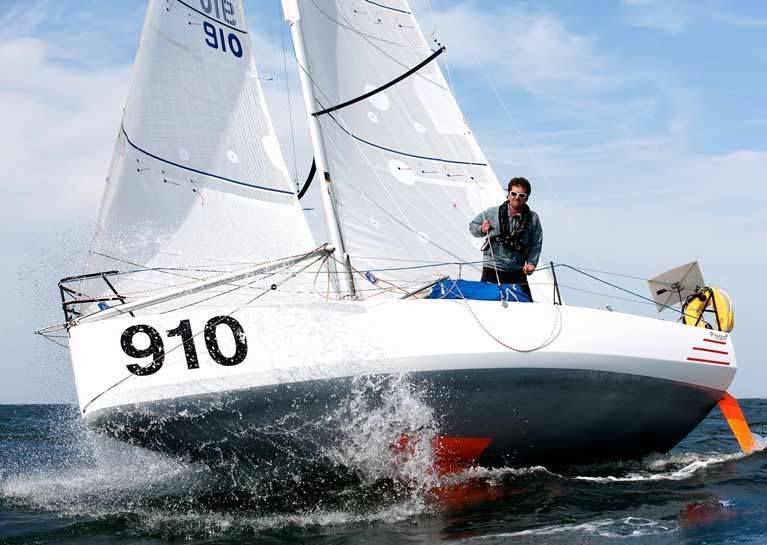 Tom Dolan in the early days with his Pogo 3 before he signed up Smurfit-Kappa as sponsors
Tom Dolan in the early days with his Pogo 3 before he signed up Smurfit-Kappa as sponsors
Thus the Pogo Foiler will be seen as the natural entry point for many who aspire to the big time, which has the Vendee Globe at its peak. And with the news that two-times Figaro winner Nicolas Troussel has now confirmed his new IMOCA 60 is building with Corum sponsorship, the 2020 staging of the big one is going to see at least eight new boats – all with the latest gizmos and then some – lining up to take on the challenge of the Great Southern Ocean with a large additional assortment of boats of older origins.
The interest this all arouses – starting with foiling Moths and going on through the Pogo Foiler, then progressing through the new foiling Figaro 3 and various state-of-the-art Class 40s before we arrive at the IMOCA 60s and the hyper-foiled America’s Cup boats – this interest is all grist to the mill of our select group of dedicated Afloat.ie futurist readers.
These are the Determined Modernists who are firmly of the opinion that that we should accept that sailing is a vehicle sport with exciting new developments, and if Olympic sailing is going to reflect global sailing as it aspires to be, then the new Olympic offshore keelboat – due to join the five ring circus at the Olympics in France in 2024 – should be a state-of-the-art foiler rather than the standard keelboat currently proposed.
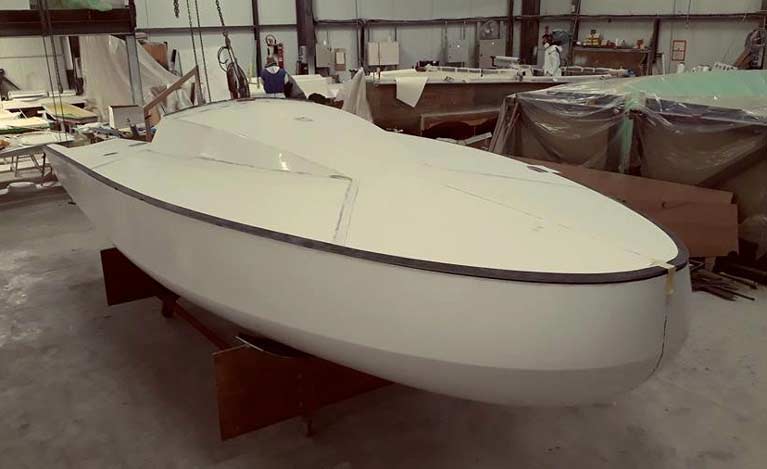 Prototype of the new Pogo Classe Mini Foiler being built in Brittany
Prototype of the new Pogo Classe Mini Foiler being built in Brittany
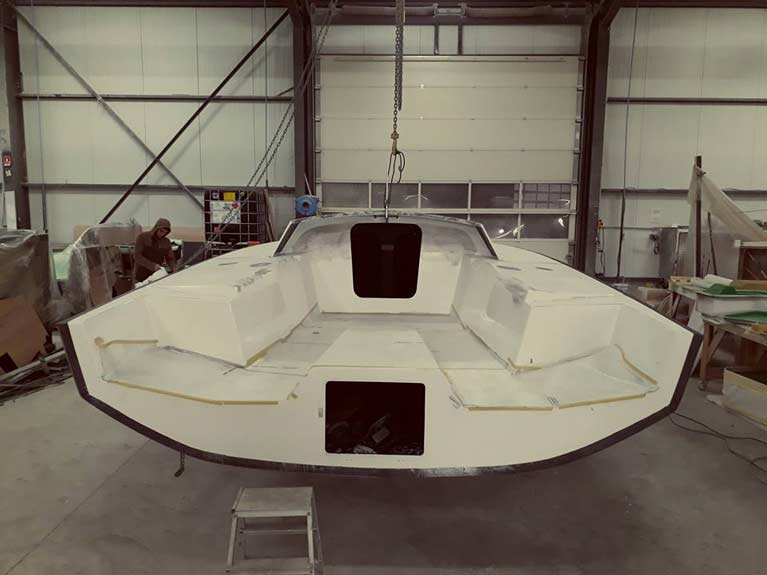 From astern, the new Pogo Foiler’s hull looks fairly normal, even if it’s abundantly clear there’ll be no easygoing lounging in the companionway
From astern, the new Pogo Foiler’s hull looks fairly normal, even if it’s abundantly clear there’ll be no easygoing lounging in the companionway
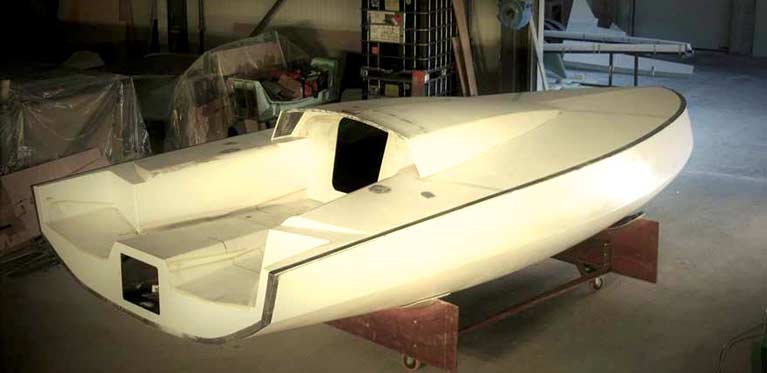 The hull shape is in line with Mini thinking, with this bluff-bowed form being most successfully pioneered by Ian Lipinski’s all-conquering Griffon
The hull shape is in line with Mini thinking, with this bluff-bowed form being most successfully pioneered by Ian Lipinski’s all-conquering Griffon
My apologies to those readers who glimpsed the headline and assumed they were going to learn much of the Dusseldorf Boat Show 2019, yet find we’ve ended up discussing the new Olympic keelboat. But maybe that’s the point of it – there’s much more to an important boat show than meets the eye, even if in Dusseldorf the eye and brain are already overwhelmed by exhibits which go on and on through something like 17 different exhibitions halls of various types and size.
Thus if an international Irish agent such as MGM Boats has offered to give you guidance in getting around this enormous marine cornucopia of floatable goodies, take the offer with grateful thanks.
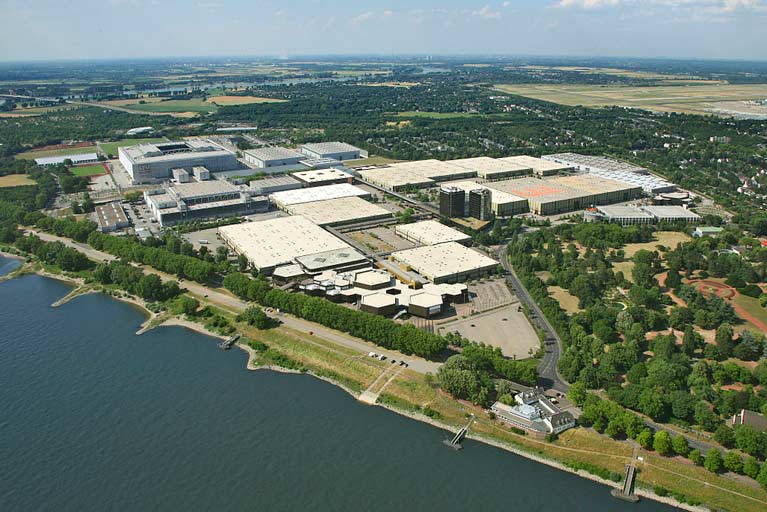 The huge Dusseldorf Exhibition Centre is strategically located between the River Rhine and the airport
The huge Dusseldorf Exhibition Centre is strategically located between the River Rhine and the airport
For not only is the Dusseldorf show on such a scale that it has at least three official entrances, it is also very much the happening place. Although there’s access from today, what we might call the Grand Opening takes place on Monday, and it is being performed by Sir Robert Knox-Johnston, no less, the first man to sail non-stop around the world fifty years ago, and achiever of very many significant maritime feats since.
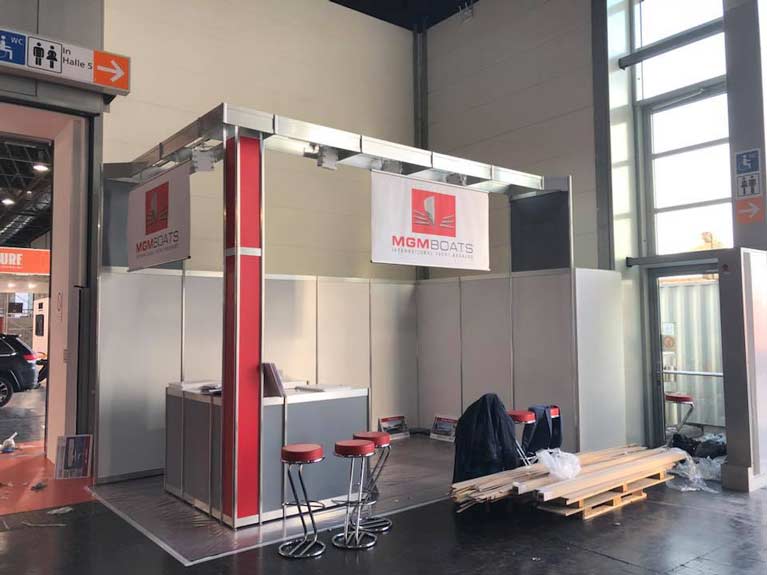 The MGM Boats Irish brokerage stand under construction in Dusseldorf this week
The MGM Boats Irish brokerage stand under construction in Dusseldorf this week
With the Brexit debate bashing our ears and brains into numbness, there’s much to be read into the fact that Britain’s greatest sailor is being hailed as a star in Germany in the same way as he is already regarded in France. He is, of course, British to the core, the very essence of Englishness, yet he acknowledges that France has a certain attitude to big-time sailing that makes it a world leader in the sport and its development, and by being in Dusseldorf on Monday he represents those of us on offshore islands who have to accept that, in terms of staging the biggest boat show, mainland Europe is where it’s at.
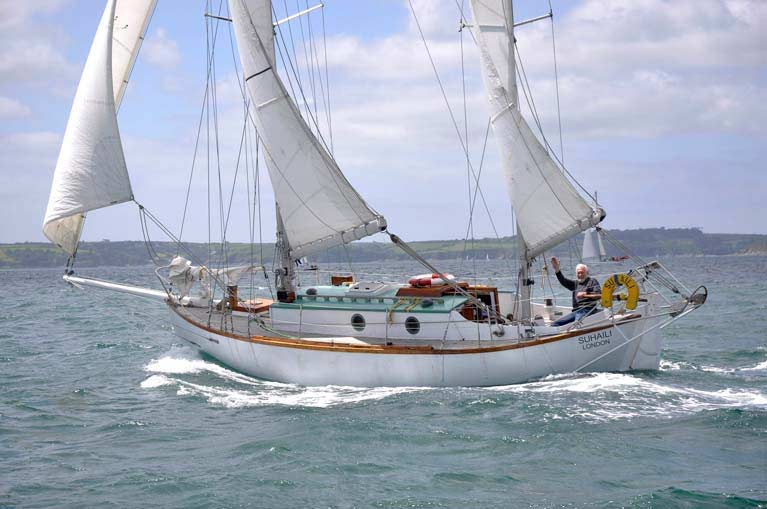 Global circumnavigator Suhaili enjoying some perfect sailing with pioneering lone skipper Robin Knox-Johnston on the helm
Global circumnavigator Suhaili enjoying some perfect sailing with pioneering lone skipper Robin Knox-Johnston on the helm
Doubtless the day is not too far distant – if it hasn’t happened already – when southeast Asia and China will see a show even bigger than Dusseldorf. But from Ireland and Britain, it’s thought-provoking to notice that the only Boat Show of significance now staged in these islands is at Southampton in September.
Yet although Dusseldorf hoovers up much of the European attention, it’s worth noting that in Europe there are somehow also boat shows of significant size in Paris, Budapest, Portugal, Hamburg, Helsinki, Gothenburg, Monaco, Cannes and Zagreb to name only a few, while if you move the slightest bit towards Asia, Turkey provides an impressive international nautical crossroads for the CNR Eurasia Boat Show at Istanbul.
But while Boat Shows inevitably reflect the need for central access to large populations, big offshore sailing events need clear blue water, and it could be argued that European sailing’s equivalent of the boat show dominance of Dusseldorf is to be found in the complete pre-eminence of the RORC Fastnet Race, where hundreds of boat take part with all available entry places snapped up within minutes of going on-line. And as the Fastnet Race in turn introduces people to Ireland, a sense of shared experience spreads right across Europe.
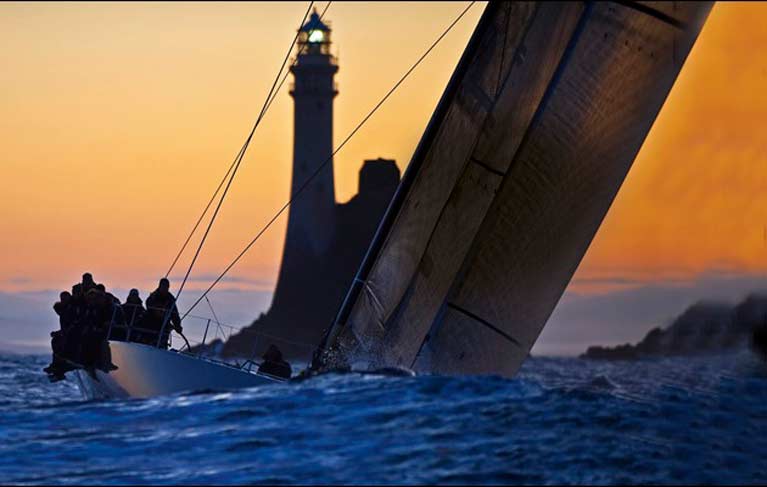 Racing round the Fastnet Rock – this spectacular introduction to the Irish coast is now part of the shared European sailing experience. Photo: Rolex
Racing round the Fastnet Rock – this spectacular introduction to the Irish coast is now part of the shared European sailing experience. Photo: Rolex
The overall picture of the centralisation of events owes much to the contemporary cheapness of air fares, and the multiplicity of available routes. Why make a rather mundane one-day journey to a more localised boat show, when you can combine a city break with two or three days away, and sample a different place and culture combined with a seriously large boat show while you’re at it?
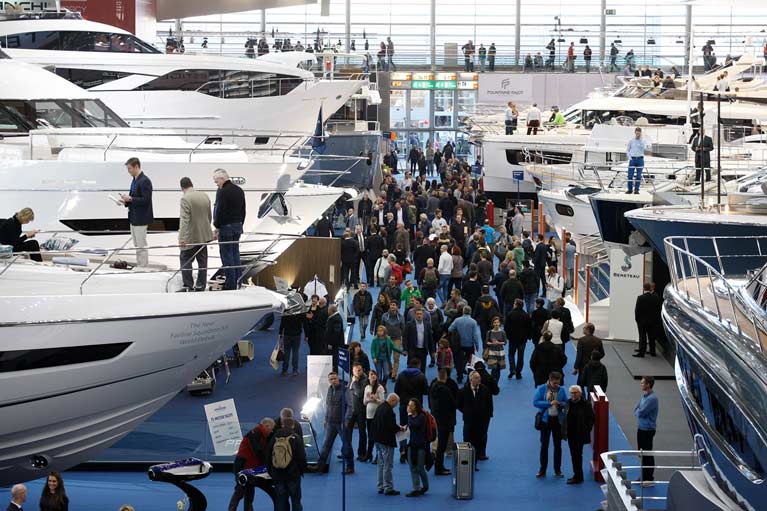 Dusseldorf Boat Show – an impressive footfall for an extensive display, and just the right amount of space
Dusseldorf Boat Show – an impressive footfall for an extensive display, and just the right amount of space
The upshot of it is that you meet Irish people who have bought boats from Irish agents, but the business has been done at a boat show in another country, such that in many cases the boat in question will never actually be in Ireland. And her crew in sailing her on foreign shores will be surprised at how many similarly set-up Irish boats and crews they meet in their cruising.
The reality of this is that it brings the risk of a hollowing-out of come aspects of Irish local sailing, though in fact a more detailed examination of the home scene shows that our club sailing is doing very nicely, thank you, provided that there are inspiring class leaders and encouragers who can build on new levels of interest.
For although people claim they’ve less free time than ever before, life is lived at a much faster pace these days, and there’s many a sailing fan who can combine local sport with judiciously-timed breaks on some more exotic sailing coast.
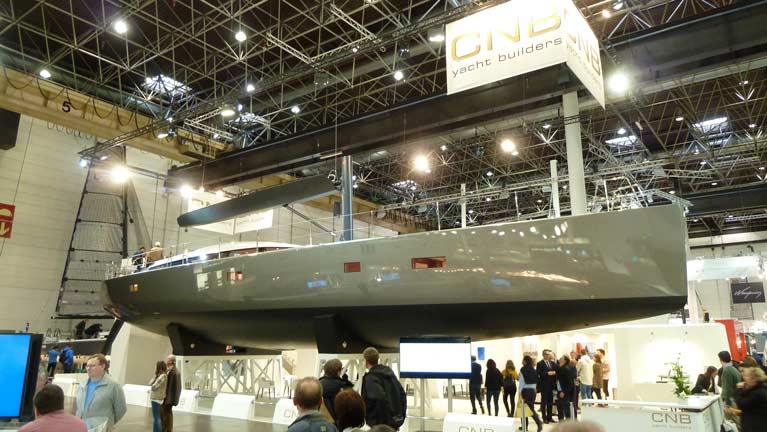 A vision of comfortable yet swift sailing in the sun – the Bordeaux-built CNB 76 at Dusseldorf.
A vision of comfortable yet swift sailing in the sun – the Bordeaux-built CNB 76 at Dusseldorf.
So by all means go to Dusseldorf Boat Show. But don’t forget that you’ll be rubbing shoulders with continental folk who would give an arm and a leg to live in some nice little Irish coastal suburb with a friendly local sailing scene and some of the best club racing – often in boats of wonderful character and history – to be had anywhere, and all of it just down the road, while you also have the option of every so often flying off into the blue and joining a boat in a port where the aroma of the neighbouring countryside and the local cooking gives that magical feeling of being abroad.
All of which is a reminder that in the final analysis, boat shows are ultimately about dreams. And in the biggest show of all, you can dream very big indeed
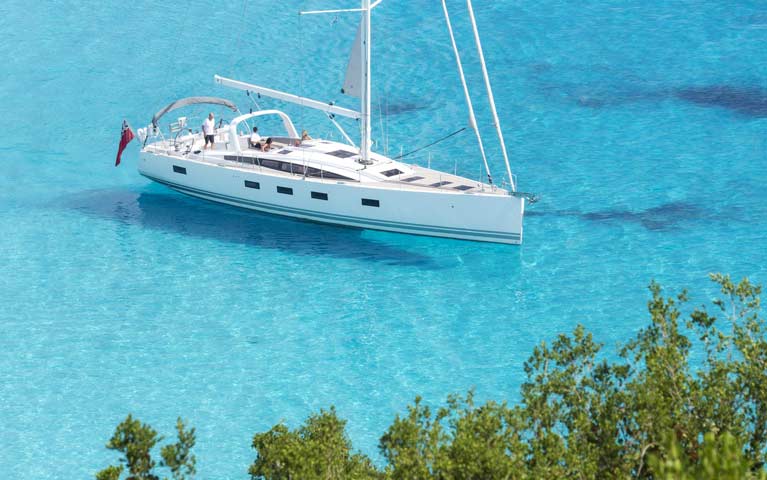 Boat Shows are ultimately all about dreams which can come true...
Boat Shows are ultimately all about dreams which can come true...
Boot Dusseldorf Opens on Saturday
Boot Dusseldorf, the 48th International Boat Show, will open this Saturday and continue through Jan. 29 at the fairgrounds in Dusseldorf, Germany.
Organisers said the event will reflect the international market with a broad range of boats, yachts and water sports equipment.
About 1,800 exhibitors from 60 countries will participate in boot 2017 in 2.3 million square feet. All 17 exhibition halls will be occupied, providing a complete overview of the world market for water sports. Irish exhibitors, MGM Boats will be on the Jeanneau, Lagoon (Hall 15 A44) and Aquador stands. Bobby Nash of Latitude from Kinsale, among several others Irish firms, will also be at the massive show.
Organisers said more than 50 percent of the exhibitors come from European countries (especially from the Netherlands, Italy, France and Great Britain) and overseas.
Market leaders Jeanneau, Beneteau, Bavaria and Hanse will be represented again, highlighting interesting advances in their development operations. Other exhibitors will include Hallberg Rassy, Dufour, X Yachts, Oyster CNB and Swan.
#boatsforsale – Ireland's MGM Boats got off to a busy start at this weekend's opening of Boot, the Dusseldorf Boat Show. It's an upswing in fortunes for yacht sales that that started off at the London Boat Show earlier this month where the international brokers also reported the strongest interest in five years. The MGM Yachts for Sale Stand is the only Irish and UK broker exhibiting on its own stand in Hall 4 of this week's massive German Show.
The Dun Laoghaire firm is promoting more than 300 used boats from its international brokerage listing as well as promoting the Aquador, Jeanneau, Sunseeker and Lagoon marques.


























